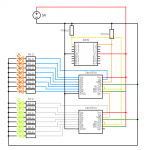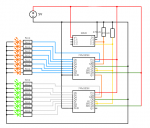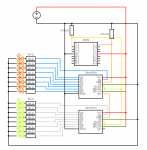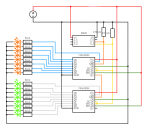GenericEvilGenius
New Member
So I have a test circuit that consists of 16 LEDs, driven by a pair of 74hc595N shift registers, and controlled by an 18M2. It works perfectly, but when I try changing the 18M2 to an 08M2 (since my application doesn't need that many pins) the whole thing fails (LED's either won't light up, or light up randomly). As far as I can see the two circuits should be identical, am I missing something? is there some difference in the capabilities of the two IC's that would make one work where the other doesn't?
Quick and dirty wiring diagrams:
With 18M2 (works)

With 08M2 (doesn't work)

Program Code, same on both applications:
Quick and dirty wiring diagrams:
With 18M2 (works)

With 08M2 (doesn't work)

Program Code, same on both applications:
Code:
start:
'init logic
symbol RFRESH = C.0
symbol SER = C.1
symbol SRCLK = C.2
symbol LBTN = C.3'reassign from C.3 to C.6 for testing on 18M2
symbol RBTN = C.4
symbol MBTN = C.5
symbol LoopCount = b4
LOW RFRESH
LOW SRCLK
LoopCount = 0
mainloop:
DO WHILE LoopCount < 16
gosub IncDisplay
pause 1000
LOOP
DO WHILE LoopCount > 0
gosub DecDisplay
pause 1000
LOOP
goto mainloop
stop
IncDisplay:
HIGH SER
pause 100
HIGH SRCLK
pause 100
LOW SRCLK
inc LoopCount
return
DecDisplay:
LOW SER
pause 100
HIGH SRCLK
pause 100
LOW SRCLK
dec LoopCount
returnAttachments
-
32.3 KB Views: 12
-
31.6 KB Views: 13


